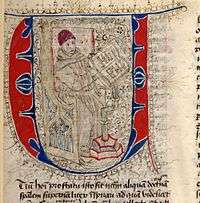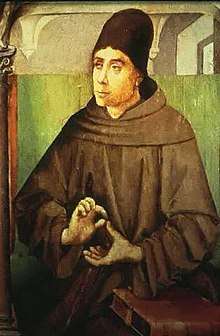Haecceity
"Haecceity" (/hɛkˈsiːɪti, hiːk-/; from the Latin haecceitas, which translates as "thisness") is a term from medieval scholastic philosophy, first coined by followers of Duns Scotus to denote a concept that he seems to have originated: the discrete qualities, properties or characteristics of a thing that make it a particular thing. Haecceity is a person's or object's thisness, the individualising difference between the concept "a man" and the concept "Socrates" (i.e., a specific person).[1]
| Part of a series on |
| John Duns Scotus |
|---|
 |
|
Scholasticism Univocity Haecceity Immaculate conception Beatific vision Formal distinction Hylomorphism Scotistic realism Substance theory (ousia) Accident Substantial form Quiddity (essence / nature) Individuation Existence of God Christology Dunce cap Platonic realism Categories (Aristotle) Problem of universals Metaphysics Christianity and slavery |
|
Works Opus Oxoniense Tractatus de Primo Principio Quaestiones Quodlibetales |
|
Influences Aristotle ("The Philosopher") St. Paul ("The Apostle") Pseudo-Dionysius St. Augustine ("The Theologian") St. Boethius Avicenna Peter Lombard ("The Master") Averroes ("The Commentator") Maimonides ("Rabbi Moses") St. Albertus Magnus ("The Universal Doctor") St. Thomas Aquinas ("The Angelic Doctor") |
|
Related Aristotelianism Franciscan Order Oxford University Catholic theology List of Franciscan theologians Empiricism |
|
|
Etymology
Haecceity is a literal translation of the equivalent term in Aristotle's Greek to ti esti (τὸ τί ἐστι)[2] or "the what (it) is."
Charles Sanders Peirce later used the term as a non-descriptive reference to an individual.[3]
Quiddity
Haecceity may be defined in some dictionaries as simply the "essence" of a thing, or as a simple synonym for quiddity or hypokeimenon. However, the term is sometimes used differently in philosophy. Whereas haecceity refers to aspects of a thing that make it a particular thing, quiddity refers to the universal qualities of a thing, its "whatness", or the aspects of a thing it may share with other things and by which it may form part of a genus of things.[4]
Duns Scotus makes the following distinction:
Because there is among beings something indivisible into subjective parts—that is, such that it is formally incompatible for it to be divided into several parts each of which is it—the question is not what it is by which such a division is formally incompatible with it (because it is formally incompatible by incompatibility), but rather what it is by which, as by a proximate and intrinsic foundation, this incompatibility is in it. Therefore, the sense of the questions on this topic [viz. of individuation] is: What is it in [e.g.] this stone, by which as by a proximate foundation it is absolutely incompatible with the stone for it to be divided into several parts each of which is this stone, the kind of division that is proper to a universal whole as divided into its subjective parts?
— Duns Scotus, Ordinatio II, d. 3, p. 1. q. 2, n. 48]
While terms such as haecceity, quiddity, noumenon and hypokeimenon all evoke the essence of a thing, they each have subtle differences and refer to different aspects of the thing's essence.
Haecceity thus enabled Scotus to find a middle ground in the debate over universals between Nominalism and Realism.[5]
Sociology and philosophy
The social construction of reality, ethnomethodology, and conversation analysis are the main streams that elaborated during the 1960s a new kind of sociology—which influenced later sociology, philosophy, and political analysis. Harold Garfinkel is the founder of ethnomethodology, and teacher of Harvey Sacks, one of the founders of conversation analysis. He used the word haecceity in his seminal Studies in Ethnomethodology (1967), to enhance the indexical inevitable character of any expression, behavior or situation. According to him, the members display the social order they refer to within the settings of the situation they contribute to define. The study of particular situations in their "haecceity" — aimed at disclosing the ordinary, ongoing social order that is constructed by the members and their practices[6] — is the object of ethnomethodology.
In his famous paper generally referred to as "Parson's Plenum" (1988), Garfinkel used the term "Haecceities" to indicate the importance of the infinite contingencies in both situations and practices.[7]
Garfinkel was drawing on phenomenology and Edmund Husserl, logic and Bertrand Russell, and perception theory and Nelson Goodman. Phenomenology is the field of studying the phenomena as such, and can thus be seen as a contemporary philosophical version of the medieval concept of haecceity.
Gilles Deleuze uses the term to denote entities that exist on the plane of immanence. The usage was likely chosen in line with his esoteric concept of difference and individuation, and critique of object-centered metaphysics.
Influence
Gerard Manley Hopkins drew on Scotus — whom he described as “of reality the rarest-veined unraveller”[8] — to construct his poetic theory of inscape.
James Joyce made similar use of the concept of haecceitas to develop his idea of the secular epiphany.[9]
James Wood refers extensively to haecceitas (as "thisness") in developing an argument about conspicuous detail in aesthetic literary criticism.[10]
See also
- Entitativity
- Formal distinction
- Haecceitism
- Hypostasis
- Identity of indiscernibles
- Objective precision
- Ostensive definition
- Personal identity
- Principle of individuation
- Quiddity
- Rigid designation
- Scotism
- Scotistic realism
- Ship of Theseus
- Sine qua non
- Cf. Sanskrit tathata, "thus-ness"
References
- Gardner, W. H., Gerard Manley Hopkins (1975), p. xxiii
- Aristotle, Metaphysics, 1030a
- Bertman, M. A., Humanities Insights (2007), p. 39
- Hicks, P., The Journey So Far (2003), p. 218
- Hicks, p. 218
- Button, G., ed., Ethnomethodology and the Human Sciences (1991), p. 10
- Rawls, Ann (2003), "Harold Garfinkel", in Ritzer, George (ed.), The Blackwell companion to major contemporary social theorists, Malden, Massachusetts Oxford: Blackwell, ISBN 9781405105958.CS1 maint: ref=harv (link) Also available as: Rawls, Ann (2003). "Harold Garfinkel". Chapter 5. Harold Garfinkel. Wiley. pp. 122–153. doi:10.1002/9780470999912.ch6. ISBN 9780470999912.CS1 maint: ref=harv (link) Extract.
- Duns Scotus's Oxford quoted in Gardner, p. xxiv
- Kearney, R., Navigations (2007), pp. 133–4
- Bartosch, R., EnvironMentality: Ecocriticism and the Event of Postcolonial Fiction (Amsterdam & New York: Rodopi, 2013), p. 270.
Further reading
- E. Gilson, The Philosophy of the Middle Ages (1955)
- A. Heuser, The Shaping Vision of Gerard Manley Hopkins (OUP 1955)
- E. Longpre, La Philosophie du B. Duns Scotus (Paris 1924)
- Gilles Deleuze and Félix Guattari. 1980. A Thousand Plateaus. Trans. Brian Massumi. London and New York: Continuum, 2004. Vol. 2 of Capitalism and Schizophrenia. 2 vols. 1972–1980. Trans. of Mille Plateaux. Paris: Les Editions de Minuit. ISBN
- Gilles Deleuze and Félix Guattari. 1991/1994. "What is Philosophy?". Trans. Hugh Tomlinson and Gregory Burchell. New York: Columbia University Press, 1994.
- Harold Garfinkel, 'Evidence for Locally Produced, Naturally Accountable Phenomena of Order, Logic, Meaning, Method, etc., in and as of the Essentially Unavoidable and Irremediable Haecceity of Immortal Ordinary Society', Sociological Theory Spring 1988, (6)1:103-109
External links

- Singularity
- Stanford Encyclopedia of Philosophy article — "Medieval Theories of Haecceity"


